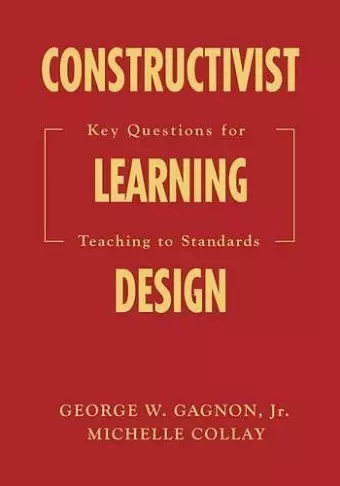Constructivist Learning Design
Key Questions for Teaching to Standards
Michelle Collay author George W Gagnon author
Format:Hardback
Publisher:SAGE Publications Inc
Published:9th Mar '06
Currently unavailable, and unfortunately no date known when it will be back
This hardback is available in another edition too:
- Paperback£33.99(9781412909563)

"Very practical and user-friendly . . ."
--Linda R. Kroll, Professor
Department of Education, Mills College
Build student-centered learning into your standards-based curriculum and lesson plans!
Educators expect learners to solve problems, think critically, communicate effectively, and collaborate well. These complex processes require young learners to engage in active learning and to understand that their own experience is the foundation for new learning. They also require teachers to move from the traditional role of "sage on the stage" to the new role of "guide on the side."
Constructivist Learning Design offers teachers a six-step framework for lesson planning and assessment:
- Situation: develop goals, tasks, and curriculum standards
- Grouping: group students and materials, and use cooperative learning
- Bridge: recall prior knowledge using students′ cognitive maps, skills, values, motivation, and expectations
- Task: use higher-level thinking skills and problem-based learning
- Exhibit: arrange student portfolios and work samples
- Reflection: synthesize critical thinking and knowledge
With clear classroom applications and ready-to-use planning templates, this research-based resource guides teachers through the complex process of aligning constructivist learning events with standards-based curriculum. Engage students in tasks, help them think for themselves, and support them in making meaning of their learning!
"A very useful contribution to the field. . . . Provides a model that even the newest of teachers can use." -- Geraldine Lefoe
"Provides a structured format for helping teachers design constructivist learning opportunities. . . There are a lot of useful strategies here for teachers and good examples throughout." -- Bruce Marlowe, Associate Professor of Educational Psychology and Special Education
"Provides sound advice on many matters, including how to establish a teaching "situation," how and why to group students, how to "hook" students and draw on their interests and past experiences, and how to promote authentic exhibits of their learning." -- Clive Beck
"Very practical and user-friendly. ..This book presents a very clear set of directions and plans for instituting a new way to think about teaching and learning on a very detailed and moment-to-moment basis. The ideas are also grounded in theory and the connections between theory and practice are made explicit." -- Linda R. Kroll, Professor
"This book should be read by neophyte and seasoned teachers, by teacher educators in colleges of education, and by trainees in preservice programs. It should also be read by school administrators for insights into how to improve teacher supervision and staff development, by open-minded behaviorists looking for alternatives to direct instruction, by liberal arts professors who want to learn how to teach so that their students want to keep on learning, and by parents with children in school or with children they are schooling at home. For that matter, everyone concerned with formal education should read this book unless, of course, they already have signed the Faustian pact to search only after the qualities and techniques of authoritarian, direct instruction.
I invite you now to do as I have done. Read this fine book three times. Read it first for a general understanding of its concepts. Read it again and reflect on your own practice. Read it a third time to engage its ideas as you would engage dance partners. Then keep the book at your side for reference to its many action ideas." -- Richard A. Schmuck
"The authors make it clear that this is not your ordinary lesson planning book. This is an interactive workbook in which Gagnon and Collay encourage us as readers to work through the design process by applying the model to our own subject matter, preferrably with a partner or as part of a group so ideas can be shared and collectively reflected upon." -- Teaching Theology and Religion, July 2008, Vol. 11(3)
ISBN: 9781412909556
Dimensions: unknown
Weight: 620g
256 pages